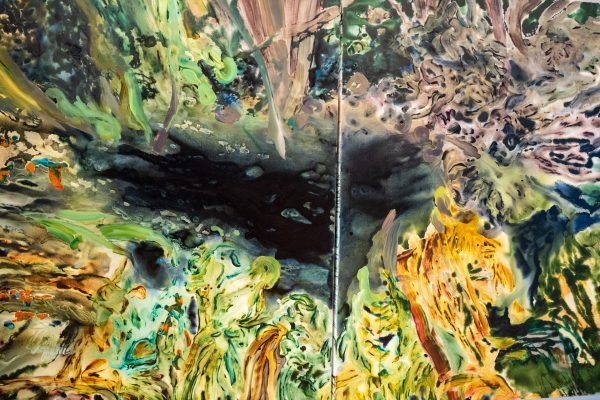Professor’s Mint Museum Exhibition Explores Complexity of Human Engagement with Nature

On her first trip to the United States, when she was still a graduate student in her native Poland, Maja Godlewska spent the summer touring America’s national parks. Afterwards, her paintings of actual and imaginary landscapes became her thesis project and launched a lifetime of considering the sublime in nature and our sometimes fraught engagement with it.
In the decades since that initial tour, Godlewska, professor of art in the Department of Art & Art History, has participated in artist residencies and exhibitions in a long list of countries around the world: Greenland, Norway, Italy, Ukraine, France, Germany, Czech Republic, Ireland, Chile, Cuba, South Korea, Mauritius and Tasmania – among others. She observes landscapes and she also observes the tourists attracted to them.
Some of her resulting works can be seen through March 1 at the Mint Museum uptown location, where Godlewska is the current “Constellation CLT” artist. The Constellation CLT series highlights the work of Charlotte artists in installations throughout the museum building.
“Sightseeing, eco-tourism and global travel may seem benign, but they alter ecosystems, reshape coastlines and leave lasting marks on jungles, oceans, monuments and mountain ranges,” says the museum’s curatorial statement. Godlewska’s paintings “confront this paradox, capturing both the awe-inspiring beauty and subtle devastation.”
This winter, Godlewska will return to Tasmania, where she was in residency in 2019, to join other artists involved in a multi-year exploration of the saltmarshes in Pipe Clay Lagoon. Her project, “Saltmarsh: a Study in Vulnerability,” is funded by an Artist Support Grant from the Arts & Science Council.
“Walks, onsite sketches and photo documentation will be part of my process, as well as potential art-actions stemming from the conversations and collaborations with other creatives,” Godlewska said. “I plan to create a series of mixed-media works on paper using locally (and sustainably) sourced materials, such as the mud and decomposing organic matter.”